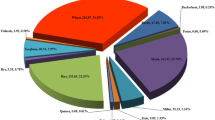Abstract
Hybrid sterility of the cross between Silewah, an Indonesian native variety and Hayakogane, a Hokkaido rice variety in Japan was confirmed to be caused by anther indehiscence, based on a lot of spikelets with fewer numbers than 3 of dehiscent anthers and fewer numbers of pollens poured onto stigma per spikelet in Silewah/Hayakogane F1. In Silewah/Hayakogane//Hayakogane BC1F1, spikelet fertility was correlated with mean number of dehiscent anthers per spikelet. So, genic analyses for hybrid sterility by anther indehiscence were conducted by scoring spikelet sterility in F2, BC1F1s and triple cross. As a result, it was concluded that the hybrid sterility was controlled by complementary action of three dominant genes. Silewah has one of the three genes and Hayakogane has the other two. It was presumed that the two genes which Hayakogane possesses were derived from those of Aikoku, an old native variety in Japan.
Similar content being viewed by others
References
Abe, N., S. Kotaka, K. Toriyama & M. Kobayashi, 1987. Breeding of rice PL-8, a new germplasm with high tolerance to sterile-type cool injury. Jpn J Breed 37(Suppl 2): 228–229 (in Japanese).
Amemiya, A. & H. Akemine, 1963. Biochemical genetic studies on the root growth inhibiting complementary lethal genes of rice plants. Bull Natl Inst Agric Sci Japan D10: 139–226.
Cheng, Y. & C.H. Huang, 1979. Studies on cytoplasmic-genetic male sterility of cultivated rice (Oryza sativa L.), I. Effect of different cytoplasm sources on male abnormalities at anthesis. J Agr Assoc China New Series 106: 1–22.
Ikehashi, H. & H. Araki, 1984. Varietal screening of compatibility types revealed in F1 fertility of distant crosses in rice. Japan J Breed 34: 304–313.
Ikehashi, H. & H. Araki, 1986. Genetics of F1 sterility in remote crosses of rice. In: Rice Genetics, pp. 119–130. International Rice Research Institute, Manila.
Ikehashi, H. & H. Araki, 1988. Multiple alleles controlling F1 sterility in remote crosses of rice (Oryza sativa). Japan J Breed 38: 283–291.
Jennings, P.R., 1966. Evaluation of partial sterility in Indica × Japonica rice hybrids. Int Rice Res Inst Tech Bull 5: 1–63.
Kato, S., 1930. On the affinity of the cultivated varieties of rice plants, Oryza sativa L. J Dept Agric Kyusyu Imp Univ 2: 241–276.
Kaul, M.L.H., 1988. Male sterility in higher plants. Springer-Verlag, Berlin.
Kitamura, E., 1962a. Studies on cytoplasmic sterility of hybrids in distantly related varieties of rice, Oryza sativa L. I. Fertility of the F1 hybrids between strains derived from certain Philippine × Japanese variety crosses and Japanese varieties. Japan J Breed 12: 13–16 (in Japanese with English summary).
Kitamura, E., 1962b. Studies on cytoplasmic sterility of hybrids in distantly related varieties of rice, Oryza sativa L. II. Analysis of nuclear genes in Japanese varieties controlling cytoplasmic sterility. Japan J Breed 12: 30–32 (in Japanese with English summary).
Maekawa, M., K. Kariya, T. Satake & F. Kita, 1987. Genic analysis for cool tolerance of foreign rice varieties. 1. Gene(s) for cool tolerance of Silewah. Japan J Breed 37(Suppl 1): 184–185 (in Japanese).
Maekawa, M., T. Inukai & N. Shinbashi, 1991. Spikelet sterility in F1 hybrids between rice varieties Silewah and Hayakogane. Japan J Breed 41: 359–363.
Morinaga, T. & H. Kuriyama, 1955. Japonica type rice in the subcontinent of India and Java. Japan J Breed 5: 149–153.
Morinaga, T. & H. Kuriyama, 1958. Intermediate type of rice in the subcontinent of India and Java. Japan J Breed 7: 253–259.
Morishima, H. & H.I. Oka, 1981. Phylogenetic differentiation of cultivated rice, 22. Numerical evaluation of the Indica-Japonica differentiation. Japan J Breed 31: 402–413.
Oka, H.I., 1957. Phylogenetic differentiation of cultivated rice. XV. Complementary lethal genes in rice. Japan J Genet 32: 83–87.
Oka, H.I., 1974. Analysis of genes controlling F1 sterility in rice by the use of isogenic lines. Genet 77: 521–534.
Saruyama, H. & N. Shinbashi, 1992. Identification of specific proteins from seed embryo by two-dimensional gel electrophoresis for the discrimination between indica and japonica rice. Theor Appl Genet 84: 947–951.
Satake, T. & K. Toriyama, 1979. Two extremely cool-tolerant varieties. Int Rice Res Newslett 4: 9–10.
Sato, Y.I. & H. Morishima, 1987. Studies on the distribution of complementary genes causing F1 weakness in common rice and its wild relatives. 2. Distribution of two complementary genes, Hwc-1 and Hwc-2 in native cultivars and its wild relatives of tropical Asia. Euphytica 36: 425–431.
Sawada, S., 1976. Frequency of indehiscent anthers and sterility, induced by low temperature at the booting stage in rice plants. Res Bull Obihiro Univ 10: 195–201.
Tamaru, N., 1991. Frequency of pollen grain stainability with I-KI solution and features of genetic male sterile mutants in rice at anthesis. J Hokkaido Univ Educ (Sec II B) 42: 67–78 (in Japanese with English summary).
Yabuno, T., 1977. Genetic studies on the interspecific cytoplasm substitution lines of Japonica varieties of Oryza sativa L. and O. glaberrima Steud. Euphytica 26: 451–463.
Author information
Authors and Affiliations
Rights and permissions
About this article
Cite this article
Maekawa, M., Inukai, T. & Shinbashi, N. Genic analysis of hybrid sterility caused by anther indehiscence between distantly related rice varieties. Euphytica 94, 311–318 (1997). https://doi.org/10.1023/A:1002963402494
Issue Date:
DOI: https://doi.org/10.1023/A:1002963402494




